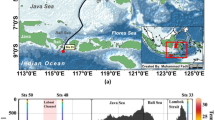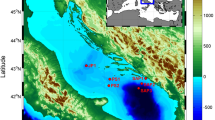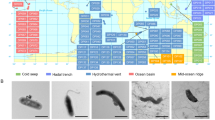Abstract
Microbial biogeographic patterns in the deep sea depend on the ability of microorganisms to disperse. One possible limitation to microbial dispersal may be the Walvis Ridge that separates the Antarctic Lower Circumpolar Deep Water from the North Atlantic Deep Water. We examined bacterial communities in three basins of the eastern South Atlantic Ocean to determine diversity and biogeography of bacterial communities in deep-sea surface sediments. The analysis of 16S ribosomal RNA (rRNA) gene clone libraries in each basin revealed a high diversity, representing 521 phylotypes with 98% identity in 1051 sequences. Phylotypes affiliated with Gammaproteobacteria, Deltaproteobacteria and Acidobacteria were present in all three basins. The distribution of these shared phylotypes seemed to be influenced neither by the Walvis Ridge nor by different deep water masses, suggesting a high dispersal capability, as also indicated by low distance–decay relationships. However, the total bacterial diversity showed significant differences between the basins, based on 16S rRNA gene sequences as well as on terminal restriction fragment length polymorphism fingerprints. Noticeably, both geographic distance and environmental heterogeneity influenced bacterial diversity at intermediate (10–3000 km) and large scales (>3000 km), indicating a complex interplay of local contemporary environmental effects and dispersal limitation.
Similar content being viewed by others
Log in or create a free account to read this content
Gain free access to this article, as well as selected content from this journal and more on nature.com
or
Accession codes
References
Abell GCJ, Bowman JP . (2005a). Ecological and biogeographic relationships of class Flavobacteria in the Southern Ocean. FEMS Microbiol Ecol 51: 265–277.
Abell GCJ, Bowman JP . (2005b). Colonization and community dynamics of class Flavobacteria on diatom detritus in experimental mesocosms based on Southern Ocean seawater. FEMS Microbiol Ecol 53: 379–391.
Baas-Becking LGM . (1934). Geobiologie of Inleiding Tot De Milieukund. WP Van Stockum and Zoom (in Dutch): The Hague, the Netherlands.
Barnett PRO, Watson J, Connelly D . (1984). A multiple corer for taking virtually undisturbed samples from shelf, bathyal and abyssal sediments. Oceanol Acta 7: 399–408.
Beja O, Koonin EV, Aravind L, Taylor LT, Seitz H, Stein JL et al. (2002). Comparative genomic analysis of archaeal genotypic variants in a single population and in two different oceanic provinces. Appl Environ Microbiol 68: 335–345.
Bent SJ, Forney LJ . (2008). The tragedy of the uncommon: understanding limitations in the analysis of microbial diversity. ISME J 2: 689–695.
Bickert T, Wefer G . (1996). Late quaternary deep water circulation in the South Atlantic: reconstruction from carbonate dissolution and benthic stable isotopes. In: Berger WH, Wefer G, Siedler G (eds). The South Atlantic: Present and Past Circulation. Springer: Heidelberg, pp 599–620.
Bowman JP, McCuaig RD . (2003). Biodiversity, community structural shifts, and biogeography of prokaryotes within Antarctic continental shelf sediment. Appl Environ Microbiol 69: 2463–2483.
Brandt A, Brenke N, Andres HG, Brix S, Guerrero-Kommritz E, Muhlenhardt-Slegel U et al. (2005). Diversity of peracarid crustaceans (Malacostraca) from the abyssal plain of the Angola Basin. Org Divers Evol 5: 105–112.
Cho JC, Tiedje JM . (2000). Biogeography and degree of endemicity of fluorescent Pseudomonas strains in soil. Appl Environ Microbiol 66: 5448–5456.
Connor EF, McCoy ED . (1979). Statistics and biology of the species-area relationship. Amer Nat 113: 791–833.
Deming JW, Colwell RR . (1982). Barophilic bacteria associated with digestive tracts of abyssal holothurians. Appl Environ Microbiol 44: 1222–1230.
Dunbar J, Ticknor LO, Kuske CR . (2001). Phylogenetic specificity and reproducibility and new method for analysis of terminal restriction fragment profiles of 16S rRNA genes from bacterial communities. Appl Environ Microbiol 67: 190–197.
Etter RJ, Grassle JF . (1992). Patterns of species-diversity in the deep-sea as a function of sediment particle-size diversity. Nature 360: 576–578.
Fierer N, Jackson RB . (2006). The diversity and biogeography of soil bacterial communities. Proc Natl Acad Sci USA 103: 626–631.
Finlay BJ . (2002). Global dispersal of free-living microbial eukaryote species. Science 296: 1061–1063.
Fuchs BM, Spring S, Teeling H, Quast C, Wulf J, Schattenhofer M et al. (2007). Characterization of a marine gammaproteobacterium capable of aerobic anoxygenic photosynthesis. Proc Natl Acad Sci USA 104: 2891–2896.
Grant A . (2000). Deep-sea diversity: overlooked messages from shallow-water sediments. Mar Ecol 21: 97–112.
Green JL, Holmes AJ, Westoby M, Oliver I, Briscoe D, Dangerfield M et al. (2004). Spatial scaling of microbial eukaryote diversity. Nature 432: 747–750.
Guezennec J, Fiala-Medioni A . (1996). Bacterial abundance and diversity in the Barbados Trench determined by phospholipid analysis. FEMS Microbiol Ecol 19: 83–93.
Harvey HR, Richardson MD, Patton JS . (1984). Lipid-composition and vertical-distribution of bacteria in aerobic sediments of the Venezuela basin. Deep Sea Res Part A 31: 403–413.
Hewson I, Fuhrman JA . (2006). Improved strategy for comparing microbial assemblage fingerprints. Microb Ecol 51: 147–153.
Horner-Devine MC, Lage M, Hughes JB, Bohannan BJM . (2004). A taxa-area relationship for bacteria. Nature 432: 750–753.
Huber T, Faulkner G, Hugenholtz P . (2004). Bellerophon: a program to detect chimeric sequences in multiple sequence alignments. Bioinformatics 20: 2317–2319.
Hughes DJ, Gage JD . (2004). Benthic metazoan biomass, community structure and bioturbation at three contrasting deep-water sites on the northwest European continental margin. Prog Oceanogr 63: 29–55.
Kato C, Yanagibayashi M, Nogi Y, Li L, Horikoshi K . (1999). Changes in the microbial community in deep-sea sediment during cultivation without decompression. In: Ludwig H (ed). Advances in High Pressure Bioscience and Biotechnology. Springer: Heidelberg, pp 11–15.
Konstantinidis KT, Tiedje JM . (2005). Towards a genome-based taxonomy for prokaryotes. J Bacteriol 187: 6258–6264.
Legendre P, Legendre L . (1998). Numerical Ecology. Elsevier Science BV: Amsterdam.
Li L, Kato C, Horikoshi K, Tsujii K . (1999). Microbial diversity in the sediments collected from cold-seep areas and from different depths of the deep-sea. In: Horikoshi K, Tsujii K (eds). Extremophiles in Deep-Sea Environments. Springer: Tokyo, pp 55–88.
Ludwig W, Strunk O, Westram R, Richter L, Meier H, Yadhukumar et al. (2004). ARB: a software environment for sequence data. Nucleic Acids Res 32: 1363–1371.
Maidak BL, Olsen GJ, Larsen N, Overbeek R, McCaughey MJ, Woese CR . (1996). The Ribosomal Database Project (RDP). Nucleic Acids Res 24: 82–85.
Mantel N . (1967). Detection of disease clustering and a generalized regression approach. Cancer Res 27: 209–220.
Martiny JBH, Bohannan BJM, Brown JH, Colwell RK, Fuhrman JA, Green JL et al. (2006). Microbial biogeography: putting microorganisms on the map. Nat Rev Microbiol 4: 102–112.
Muyzer G, Teske A, Wirsen CO, Jannasch HW . (1995). Phylogenetic relationships of Thiomicrospira species and their identification in deep-sea hydrothermal vent samples by denaturing gradient gel-electrophoresis of 16S rDNA fragments. Arch Microbiol 164: 165–172.
O’Malley MA . (2008). ‘Everything is everywhere: but the environment selects’: ubiquitous distribution and ecological determinism in microbial biogeography. Stud Hist Philos Biol Biomed Sci 39: 314–325.
Osborn AM, Moore ERB, Timmis KN . (2000). An evaluation of terminal-restriction fragment length polymorphism (T-RFLP) analysis for the study of microbial community structure and dynamics. Environ Microbiol 2: 39–50.
Papke RT, Ramsing NB, Bateson MM, Ward DM . (2003). Geographical isolation in hot spring cyanobacteria. Environ Microbiol 5: 650–659.
Polymenakou PN, Bertilsson S, Tselepides A, Stephanou EG . (2005). Bacterial community composition in different sediments from the Eastern Mediterranean Sea: a comparison of four 16S ribosomal DNA clone libraries. Microb Ecol 50: 447–462.
Polymenakou PN, Lampadariou N, Mandalakis M, Tselepides A . (2009). Phylogenetic diversity of sediment bacteria from the southern Cretan margin, Eastern Mediterranean Sea. Syst Appl Microbiol 32: 17–26.
Queric NV, Soltwedel T . (2007). Impact of small-scale biogenic sediment structures on bacterial distribution and activity in Arctic deep-sea sediments. Mar Ecol-Evol Persp 28: 66–74.
Ramette A . (2009). Quantitative community fingerprinting methods for estimating the abundance of operational taxonomic units in natural microbial communities. Appl Environ Microbiol 75: 2495–2505.
Ramette A, Tiedje JM . (2007). Biogeography: an emerging cornerstone for understanding prokaryotic diversity, ecology, and evolution. Microb Ecol 53: 197–207.
Ravenschlag K, Sahm K, Pernthaler J, Amann R . (1999). High bacterial diversity in permanently cold marine sediments. Appl Environ Microbiol 65: 3982–3989.
Reche I, Pulido-Villena E, Morales-Baquero R, Casamayor EO . (2005). Does ecosystem size determine aquatic bacterial richness? Ecology 86: 1715–1722.
Rossello-Mora R, Amann R . (2001). The species concept for prokaryotes. FEMS Microbiol Rev 25: 39–67.
Santelli CM, Orcutt BN, Banning E, Bach W, Moyer CL, Sogin ML et al. (2008). Abundance and diversity of microbial life in ocean crust. Nature 453: 653–U657.
Schefuss E, Versteegh GJM, Jansen JHF, Damste JSS . (2004). Lipid biomarkers as major source and preservation indicators in SE Atlantic surface sediments. Deep-Sea Res Pt I 51: 1199–1228.
Schloss PD, Handelsman J . (2005). Introducing DOTUR, a computer program for defining operational taxonomic units and estimating species richness. Appl Environ Microbiol 71: 1501–1506.
Schloss PD, Handelsman J . (2006). Introducing SONS, a tool for operational taxonomic unit-based comparisons of microbial community memberships and structures. Appl Environ Microbiol 72: 6773–6779.
Schloss PD, Larget BR, Handelsman J . (2004). Integration of microbial ecology and statistics: a test to compare gene libraries. Appl Environ Microbiol 70: 5485–5492.
Shannon LV, Chapman P . (1991). Evidence of Antarctic bottom water in the Angola Basin at 32-degrees-S. Deep Sea Res A 38: 1299–1304.
Stackebrandt E, Ebers J . (2006). Taxonomic parameters revisited: tarnished gold standards. Microbiol Today 33: 152–155.
Staley JT, Gosink JJ . (1999). Poles apart: biodiversity and biogeography of sea ice bacteria. Annu Rev Microbiol 53: 189–215.
Suzuki M, Rappe MS, Giovannoni SJ . (1998). Kinetic bias in estimates of coastal picoplankton community structure obtained by measurements of small-subunit rRNA gene PCR amplicon length heterogeneity. Appl Environ Microbiol 64: 4522–4529.
Urakawa H, Kita-Tsukamoto K, Ohwada K . (1999). Microbial diversity in marine sediments from Sagami Bay and Tokyo Bay, Japan, as determined by 16S rRNA gene analysis. Microbiology-(UK) 145: 3305–3315.
Whitaker RJ, Grogan DW, Taylor JW . (2003). Geographic barriers isolate endemic populations of hyperthermophilic archaea. Science 301: 976–978.
Xu MX, Wang P, Wang FP, Xiao X . (2005). Microbial diversity at a deep-sea station of the Pacific nodule province. Biodivers Conserv 14: 3363–3380.
Yan S, Fuchs BM, Lenk S, Harder J, Wulf J, Jiao NZ et al. (2009). Biogeography and phylogeny of the NOR5/OM60 clade of Gammaproteobacteria. Syst Appl Microbiol 32: 124–139.
Yannarell AC, Triplett EW . (2005). Geographic and environmental sources of variation in lake bacterial community composition. Appl Environ Microbiol 71: 227–239.
Zhao J, Zeng RY . (2005). Phylogenetic analysis of bacterial community in deep-sea sediment from the western Pacific ‘warm pool’. Acta Oceanol Sin 24: 127–138.
Zheng DD, Alm EW, Stahl DA, Raskin L . (1996). Characterization of universal small-subunit rRNA hybridization probes for quantitative molecular microbial ecology studies. Appl Environ Microbiol 62: 4504–4513.
Zhou JZ, Xia BC, Treves DS, Wu LY, Marsh TL, O’Neill RV et al. (2002). Spatial and resource factors influencing high microbial diversity in soil. Appl Environ Microbiol 68: 326–334.
Acknowledgements
We thank M Türkay and P Martínez Arbizu for the invitation to participate to the Meteor cruise DIVA II (M63/2) and the captain, crew and shipboard scientific party for their assistance during sampling. We are grateful to I Kröncke and M Türkay for providing environmental data of the deep-sea sediments. The project has been carried out in the framework of the Consensus of Diversity of Abyssal Marine Life (CoML/CeDAMar) and the MarBEF Network of Excellence ‘Marine Biodiversity and Ecosystem Functioning’ (contract no. GOCE-CT-2003-505446). This work was financially supported by the Max Planck Society.
Author information
Authors and Affiliations
Corresponding author
Additional information
Supplementary Information accompanies the paper on The ISME Journal website (http://www.nature.com/ismej)
Rights and permissions
About this article
Cite this article
Schauer, R., Bienhold, C., Ramette, A. et al. Bacterial diversity and biogeography in deep-sea surface sediments of the South Atlantic Ocean. ISME J 4, 159–170 (2010). https://doi.org/10.1038/ismej.2009.106
Received:
Revised:
Accepted:
Published:
Issue date:
DOI: https://doi.org/10.1038/ismej.2009.106
Keywords
This article is cited by
-
Microbial communities in the deep-sea sediments of the South São Paulo Plateau, Southwestern Atlantic Ocean
International Microbiology (2023)
-
Environmental and Spatial Influences on Biogeography and Community Structure of Saltmarsh Benthic Diatoms
Estuaries and Coasts (2021)
-
Microbial community and geochemical analyses of trans-trench sediments for understanding the roles of hadal environments
The ISME Journal (2020)
-
Evidence for phylogenetically and catabolically diverse active diazotrophs in deep-sea sediment
The ISME Journal (2020)
-
Composition and assembly of bacterial communities in surface and deeper sediments from aquaculture-influenced sites in Eastern Lake Taihu, China
Aquatic Sciences (2020)



